Frederick Oakes Sylvester
Frederick Oakes Sylvester (October 8, 1869 – March 2, 1915) was an American art educator and artist in the Arts and Crafts movement in St. Louis, MO.
Frederick Oakes Sylvester | |
|---|---|
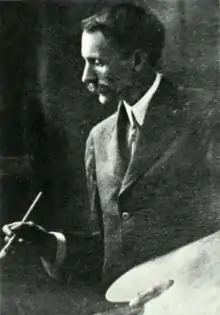 Frederick Oakes Sylvester | |
| Born | October 8, 1869 |
| Died | March 2, 1915 (aged 45) |
| Nationality | United States |
| Education | Massachusetts Normal Art School |
| Known for | Art educator and artist |
| Movement | Arts and Crafts |
| Spouse(s) | Florence I. Gerry |
| Awards | Bronze medal at the Louisiana Purchase Exposition |
Biography
Frederick Oakes Sylvester was born in Brockton, Massachusetts on October 8, 1869, the son of Charles Frederick Sylvester, a hardware dealer, and Mary Louise, who died two weeks after his birth.[1]
Sylvester's father did not encourage his son's artistic aspirations, and Sylverster as a boy sold newspapers to buy art supplies. He attended high school in Fall River, Massachusetts, and during the summer of 1887 he hiked around Massachusetts and Connecticut with a friend, camping out and sketching. He entered Massachusetts Normal Art School in 1888 and took the six-year Teacher's Course. His aunt Rebecca Noyes and his great-aunt Hannah Soule, descendant of the Mayflower Soules, financially supported him in this period. He graduated in 3 years with honors in public speaking and reading.[1]
From 1891 to 1892 he was the acting director of the Art Department of the H. Sophie Newcomb Memorial College at Tulane University, New Orleans.[1]
On December 25, 1891, Sylvester married Florence I. Gerry, a Fall River schoolteacher. They had two children: Dorothy Louise (b. 1894) and Kilburn Gerry (1899). In June 1892 Frederick O. Sylvester moved to St. Louis, Missouri, and took the position of art director at the Central High School. They lived at 5924 Horton Place, St. Louis. One of his pupils was Helen R. Rathbun. He also taught night classes at YMCA. In 1899 he was admitted to the Society of Western Artists and later became its vice-president. He was also member of the Two-by-Four Club, the Artists' Guild and the St. Louis Art League. The paintings of this period focus on the St. Louis' riverfront, specifically the area surrounding the Eads Bridge. In 1900 Sylvester exhibited twenty-five paintings of Eads Bridge at the St. Louis Exposition. By 1904 the paintings of the Eads Bridge amounted to over 100, and Sylvester became known as "the painter of the Eads Bridge". He was an impressionist documenting the growth of St. Louis' industrial life.[1]
In 1902 Sylvester went to work part-time for Principia, a young private school located at Page and Belt Avenues, St. Louis. In 1904 Sylvester won a bronze medal at the Louisiana Purchase Exposition and a silver medal at the Portland Exposition.[1]
Takuma Kajiwara moved to St. Louis in 1905, "lured to the city partly by an offer of employment in a studio and even more by a desire to see the Mississippi River," according to his obituary in the St. Louis Star-Times.[2] Kajiwara and Sylvester were friends. According to one account, their amity was "warm enough to cause them to cut wrists and mingle blood in a gesture of unity." Sylvester designed a silver watch fob for Kajiwara showing an artist and a photographer clasping hands, and carrying, on the reverse side, the statement: "No East no West, But hand in hand, Life's Unity, To Understand, T. Kajiwara, from:, F.O. Sylvester, 1909." Kajiwara did photographic work for The Great River, a book by Sylvester collecting his paintings of the Mississippi, published in 1911. Photos show the men painting together.[1]

In 1906 Sylvester spent a period in Europe. Back from Europe, Sylvester started his second period, focused his paintings on the Elsah's area. Elsah is a historic river town in Illinois and Sylvester owned a summer home, Oak Ledge, there that he bought in 1902. With Elsah, Sylvester tried to move beyond impressionism and the urban subjects of before towards the spiritual values of nature. In 1986 Paul O. Williams published Frederick Oakes Sylvester, The Artist's Encounter with Elsah. Frequent guest at Elsah were Kathryn E. Cherry, who succeeded Sylvester as Principia art director, and Takuma Kajiwara.[1]
In 1906 Sylvester was awarded the Fine Arts Building of Chicago Prize by the Society of Western Artists. In 1909 and 1910 he served as president of the St. Louis Artists' Guild. In 1910 he exhibited 28 paintings in Columbia, Missouri, for the Art Lover's Guild and gave two lectures, Artists' Ideals and The Relation of Art to Life. In 1911 the St. Louis Art Museum held a major exhibition of 83 Sylvester paintings from the Elsah years.[1]
He died in St. Louis on March 2, 1915 and, according to his wishes, a boat set out from Elsah upriver to the confluence of the Mississippi and Illinois Rivers, where his wife and Kajiwara sprinkled his ashes on the water.[1][3]
Today Frederick O. Sylvester's paintings hang in a number of institutions and private homes in the St. Louis' area.[1]
Gallery
%252C_Grapes.jpg.webp) Grapes
Grapes%252C_Gladiolas.jpg.webp) Gladiolas
Gladiolas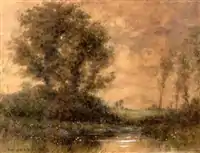 Landscape with trees and stream, 1885
Landscape with trees and stream, 1885 Landscape with farm house, 1891
Landscape with farm house, 1891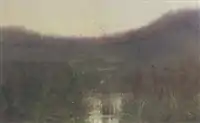 The meadow pool, 1893
The meadow pool, 1893 Mississippi harbor scene, 1897
Mississippi harbor scene, 1897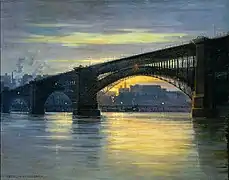 Eads Bridge
Eads Bridge%252C_Sunset%252C_March_15%252C_1900.jpg.webp) Sunset, March 15, 1900
Sunset, March 15, 1900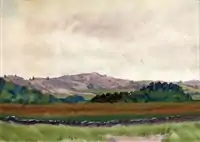 Landscape with rolling hills, 1902
Landscape with rolling hills, 1902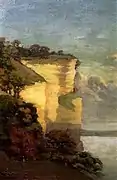 Bluffs along the river, 1902
Bluffs along the river, 1902%252C_Missouri_river_scene%252C_1903.jpg.webp) Missouri river scene, 1903
Missouri river scene, 1903 Along the Missouri river, 1904
Along the Missouri river, 1904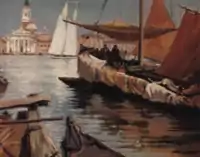 Venice, 1905
Venice, 1905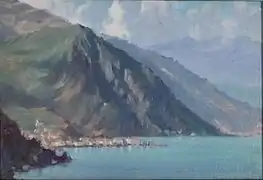 Menaggio, north from Cadenabbia, Italy
Menaggio, north from Cadenabbia, Italy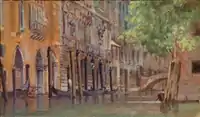 Venetian canal scene
Venetian canal scene Lake Como
Lake Como Bavarian landscape, 1906
Bavarian landscape, 1906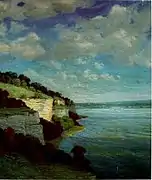 Elsah, ca. 1906
Elsah, ca. 1906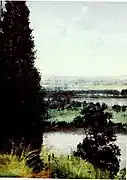 Elsah, ca. 1906
Elsah, ca. 1906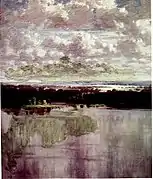 Elsah, ca. 1906
Elsah, ca. 1906 Elsah, ca. 1906
Elsah, ca. 1906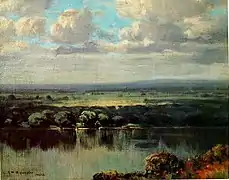 Elsah, ca. 1906
Elsah, ca. 1906 Elsah, ca. 1906
Elsah, ca. 1906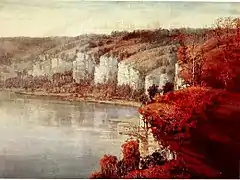 Elsah, ca. 1906
Elsah, ca. 1906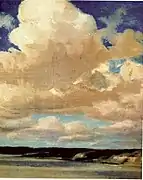 Elsah, ca. 1906
Elsah, ca. 1906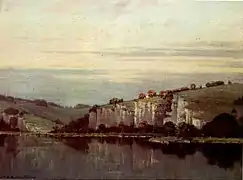 Soft Twilight Lingers, ca. 1906
Soft Twilight Lingers, ca. 1906%252C_Sunrise_through_the_Trees.jpg.webp) Sunrise through the Trees
Sunrise through the Trees%252C_Cloudy_Day.jpg.webp) Cloudy Day
Cloudy Day%252C_Bluffs_along_the_Mississippi_River.jpg.webp) Bluffs along the Mississippi River
Bluffs along the Mississippi River.jpg.webp) The Sunlit Cottenwood
The Sunlit Cottenwood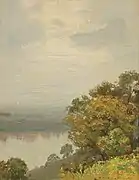 Tonalist River Landscape
Tonalist River Landscape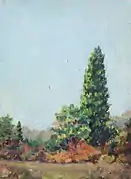 Summer landscape
Summer landscape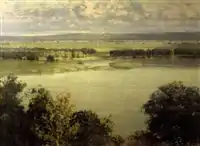 River landscape from the bluffs
River landscape from the bluffs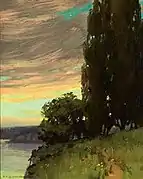 Twilight and evening star
Twilight and evening star%252C_Sunset_on_the_Mississippi%252C_1909.jpg.webp) Sunset on the Mississippi, 1909
Sunset on the Mississippi, 1909 Pageantry of sky and stream, 1909
Pageantry of sky and stream, 1909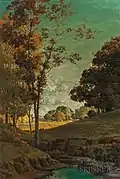 The Light that Makes the Heart Glad, 1910
The Light that Makes the Heart Glad, 1910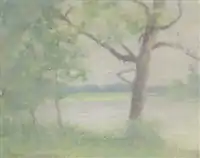 Summer landscape, 1910
Summer landscape, 1910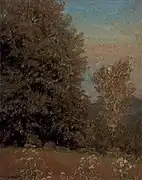 Summer landscape, 1910
Summer landscape, 1910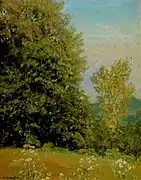 Summer landscape, 1910
Summer landscape, 1910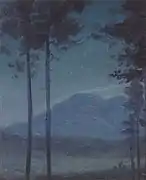 Nocturne, 1910
Nocturne, 1910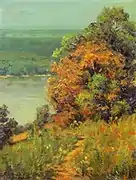 Verdant bluff landscape, 1911
Verdant bluff landscape, 1911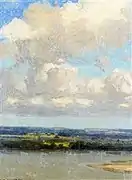 River landscape, 1911
River landscape, 1911 The song of the Mississippi, 1911
The song of the Mississippi, 1911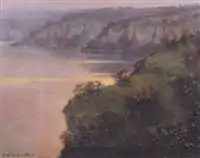 The purple Grafton Heights, 1911–1912
The purple Grafton Heights, 1911–1912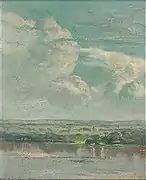 Untitled, 1912
Untitled, 1912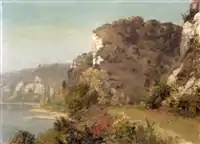 Piasa bluffs on the Mississippi, 1912
Piasa bluffs on the Mississippi, 1912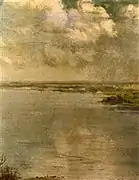 Dreaming, 1913
Dreaming, 1913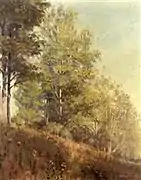 Trees a' shimmer, 1913
Trees a' shimmer, 1913
References
- Williams, Paul O. (1986). Frederick Oakes Sylvester: the artist's encounter with Elsah. Historic Elsah Foundation. Retrieved September 25, 2017.
- "St. Louis Losing Kajiwara Because He Finds After 31 Years It Is Poor Soil for His Art," St. Louis Star-Times, February 7, 1906, page 1
- "F. O. Sylvester's Funeral Friday at Artists' Guild". St. Louis Post-Dispatch. March 3, 1915. p. 11. Retrieved February 14, 2020 – via Newspapers.com.